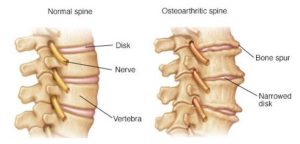WHAT IS A BONE SPUR?
Bone spurs are a tiny, smooth, and bony-like outgrowth that takes place on your bones. The growth is also known as an osteophyte and forms along the bone edges or on the facet joints of the spine.
 The bone spur can form on any part of the body like the:
The bone spur can form on any part of the body like the:
- Hands
- Shoulders
- Neck
- Knees
- Spine
- Hip
- Lower back
- Heel of the feet
In normal circumstances, the bone spur will not cause any problems within your body and will not need treatment. If they do not cause any symptoms they can remain undetected for a long time. But if they start pressing on nerves or rubbing against other bones, they might cause stiffness and pain.
In case the bone spurs causes pain, you will need to seek treatment to manage the situation. The type of treatment you seek will depend on the spur’s location and how it affects your health.
SYMPTOMS OF A BONE SPUR
Some people might have a bone spur, and they do not know it. Some even live with it for many years without noticing. It is only when they start feeling some discomfort that they start getting concerned. Here are some of the signs you have an osteophyte.
- Weakness and numbness in the legs
- Pain near the affected joint
- Stiffness in the back or neck
- Reduced motion range
- Tendinitis
- A tear of the tendon
- Bumpy areas on the fingers and toes
- Muscle spasm
- Difficulty controlling bladder or the bowel movement
Note that the symptoms might get worse if you try to exercise or even move the affected joint.
WHO CAN GET BONE SPURS?
Bone spurs grow in people aged 60 years and older, but it is also possible for young people to get the condition. But for young people to get osteophytes they must have an underlying condition like osteoarthritis (OA).
Osteoarthritis is a form of wear and tear arthritis, and it occurs when cartilage between your bones wear down.
WHAT CAUSES A BONE SPUR?
 One of the biggest causes of a bone spur is joint damage from the OA. OA is a condition that occurs when the cartilage gets destroyed. The cartilage is a firm and flexible tissue that cushions the bones and allows the bones to move with ease. The osteoarthritis develops when one gets older or after damage like a sports injury. When an injury occurs, the body will try to repair the cartilage, which will create new bone material. The new bony growth is known as osteophytes.
One of the biggest causes of a bone spur is joint damage from the OA. OA is a condition that occurs when the cartilage gets destroyed. The cartilage is a firm and flexible tissue that cushions the bones and allows the bones to move with ease. The osteoarthritis develops when one gets older or after damage like a sports injury. When an injury occurs, the body will try to repair the cartilage, which will create new bone material. The new bony growth is known as osteophytes.
Another condition that might cause the bone spur is ankylosing spondylophytes. This is a rare form of arthritis that is known to cause spinal nerve inflammation. After some time, the ankylosing might end up connecting small bones in the spine. When this happens, the body will respond by forming spinal osteophytes.
Other causes of the osteophyte are
- Obesity
- Diet
- Genes
- Overuse (working the bone for a long time)
- Spinal stenosis (narrowing of the spin)
- Bone problems (you were born with)
HOW CAN THE BONE SPUR BE DIAGNOSED?
It can be difficult to determine if the cause of the pain or numbness you feel n your body is a result of the bone spur. If you have the symptoms, you need to visit a well-equipped health care facility to have the test done. The osteophytes are detected using radiology testing like plain x-rays, ultrasound imaging, MRI scan, Myelograms, and CT scan. When you go through these tests, it will help you determine if you have osteophytes and the areas they are located in your body.
CAN BONE SPURS BE TREATED?
 You can have the bone spurs treated, only if they cause painful symptoms. The first treatment is to lessen the swelling and prevent re-injury when possible. This can be treated using the local cold application, especially when it is easy to access the bone spur.
You can have the bone spurs treated, only if they cause painful symptoms. The first treatment is to lessen the swelling and prevent re-injury when possible. This can be treated using the local cold application, especially when it is easy to access the bone spur.
Depending on the position of the spur, you might need to take some medication. Your practitioner might prescribe over-the-counter NSAIDs or a local steroid injection to deal with pain. Other options that can be used to treat the condition are orthotics, wearing shoes with cushion-like inserts, and local osteophyte pads. If the bone spurs are causing irritation of the muscles or tendons and are resilient to conservative treatments the next step is looking into surgical options.
Medications can cause side effects and should only be taken for a limited period, unless otherwise noted by your doctor.
OTHER THERAPIES FOR BONE SPURS
You can use other ways to take care of the symptoms like resting, especially if you feel that your body is overworked. You can also make use of the steroids shots to help reduce the swelling. In case you have difficulty moving, a physical therapist can guide you through rehabilitation.
WHAT IF THERE IS NO PAIN?
In case the osteophyte does not cause any pain, you might not have to get the treatment. Note that the outlook of the bone spur causing symptoms can vary. Some might be mild and hardly noticeable, while some can cause disabling symptoms. If you do not have any pain, it is best if you do not disturb the area with rigorous activity it to avoid getting complications.
CAN YOU PREVENT THE FORMATION OF BONE SPUR?
The osteophyte cannot be prevented if they are due to wear and tear or arthritis. However, if caused by other conditions, you can avoid them. Learning of the ways to prevent a bone spur is important especially if you feel that you are at risk.
Wear socks that have a wide toe box and good arch support. They should also have enough cushions for you to step on. You need to get your shoes fitted by a professional to avoid letting them rub your feet when you are walking. It is also paramount for you to put on thick socks to ensure that the shoes do not rub.
- Watch your diet and eat meals with ample vitamin D, as this will help you protect your bones.
- Do regular weight-bearing exercises to help in making sure that your bones stay strong.
- Keep fit as excess weight could lead to you developing a bone spur.


